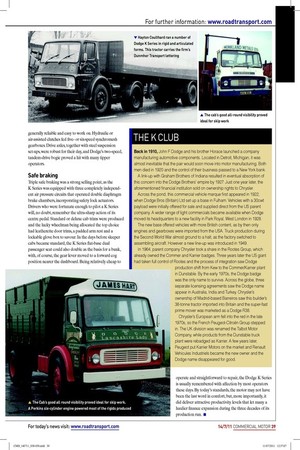THE K CLUB
Page 33

If you've noticed an error in this article please click here to report it so we can fix it.
Back in 1910, John F Dodge and his brother Horace launched a company manufacturing automotive components. Located in Detroit, Michigan, it was almost inevitable that the pair would soon move into motor manufacturing. Both men died in 1920 and the control of their business passed to a New York bank.
A link-up with Graham Brothers of Indiana resulted in eventual absorption of this concern into the Dodge Brothers’ empire by 1927. Just one year later, the aforementioned financial institution sold on ownership rights to Chrysler.
Across the pond, this commercial vehicle marque first appeared in 1922, when Dodge Bros (Britain) Ltd set up a base in Fulham. Vehicles with a 30cwt payload were initially offered for sale and supplied direct from the US parent company. A wider range of light commercials became available when Dodge moved its headquarters to a new facility in Park Royal, West London in 1928.
The new base offered vehicles with more British content, as by then only engines and gearboxes were imported from the USA. Truck production during the Second World War almost ground to a halt, as the factory switched to assembling aircraft. However a new line-up was introduced in 1949.
In 1964, parent company Chrysler took a share in the Rootes Group, which already owned the Commer and Karrier badges. Three years later the US giant had taken full control of Rootes and the process of integration saw Dodge production shift from Kew to the Commer/Karrier plant in Dunstable. By the early 1970s, the Dodge badge was the only name to survive. Across the globe, three separate licensing agreements saw the Dodge name appear in Australia, India and Turkey. Chrysler’s ownership of Madrid-based Barreiros saw this builder’s 38-tonne tractor imported into Britain and the super-fast prime mover was marketed as a Dodge R38.
Chrysler’s European arm fell into the red in the late 1970s, so the French Peugeot-Citroën Group stepped in. The UK division was renamed the Talbot Motor Company, while products from the Dunstable truck plant were rebadged as Karrier. A few years later, Peugeot put Karrier Motors on the market and Renault Vehicules Industriels became the new owner and the Dodge name disappeared for good.













































